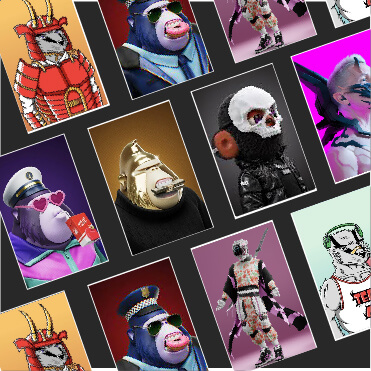Introduction
Volatility seems like a perpetual companion of the crypto and the NFT world. Just when the NFT markets were recovering from the lows of last year and rebounding, trading volumes plunged in April, only to rebound slightly in the past seven days or so.
Until mid-April, the broader NFT market too saw a downturn, with trading statistics reaching levels that were not seen for many years. These dwindling figures indicate a decrease in trading activity across the entire NFT market. Daily trades across all trading platforms have plunged by a whopping 71 per cent since mid-April.
However, true to its volatile character, NFT trading and sales volume surged again by 8.5 per cent in the past seven days or so and rose to more than US $181 million. Ethereum-based NFT led the rise by amassing nearly US $126 million, while Solana NFT recorded second with a sales volume of US $19 million.
The volatility does not seem to deter new players from exploring the potential of NFT. Blockchain company Coin Ceylon has launched Yakka, the first ever Cardano NFT project to originate from Sri Lanka. It has a collection of traditional Sri Lankan masks as Cardano NFT with real-life utility benefits.
The NFT project uses digital art to actively support and uplift the dying traditional art of mask making in Sri Lanka. A portion of the funds raised from this NFT project will be used to provide local artisans with essential supplies, equipment and materials needed to create these intricate masks.
Read on to find out more
NFT trading falls to two-year low before rebounding partially
Trading metrics at various NFT marketplaces reached their lowest point in nearly two years and top-tier NFT projects witnessed a drop in their respective value, before rebounding slightly. The broader NFT market also witnessed a downturn, with trading statistics at levels not seen for years.
Popular NFT collections such as CryptoPunks and Bored Ape Yacht Club (BAYC) have seen their floor price fall below US $100,000 worth of ETH for the first time in many months. Although the NFT have shown some recovery, the current cost of a CryptoPunk is approximately US $93,692 worth of ETH, which is a decline of more than 30 per cent from just over a month ago, when the lowest CryptoPunk was valued at slightly over US $128,000 worth of ETH.
BAYC, the popular NFT project from Yuga Labs, has also been affected as its price is the lowest it has been since November 2021. However, it emerged as the top traded NFT collection in the past seven days.
These dwindling figures indicate a decrease in trading activity across the entire NFT market. Daily trades across all trading platforms have plunged by a whopping 71 per cent since mid-April.
However, there seems to be a glimmer of hope as the NFT trading and sales volume surged 8.5 per cent in the past seven days or so and rose to more than US $181 million. Ethereum-based NFT took the lion’s share by amassing nearly US $126 million, while Solana NFT recorded second with a sales volume of US $19 million.
Polygon attracted US $15 million worth of sales volume while the balance was shared among NFT on other networks. The total number of NFT buyers also trended higher in the past few days, surging 41 per cent in the past seven days.
Sri Lanka’s first Cardano NFT collection showcases traditional art and culture
Blockchain company Coin Ceylon has launched Yakka, the first ever Cardano NFT project to originate from Sri Lanka and it comprises a ground-breaking collection of traditional Sri Lankan masks as Cardano NFT with real-life utility benefits.
The pioneering project from Sri Lanka features 6,666 unique NFT masks, including 6,000 stunning 2D designs and 666 captivating 3D animated masks, each inspired by authentic cultural folklore and Yakka masks dating back thousands of years.
Holders of these unique mask NFT will be eligible for a range of benefits such as the opportunity to have a physical mask shipped to their location worldwide, access to airdrops, NFT drops as well as partner benefits from global companies.
The NFT project uses digital art to actively support and uplift the dying traditional art of mask making in Sri Lanka. A portion of the funds raised from this NFT project will be used to provide local artisans with essential supplies, equipment and materials needed to create these intricate masks.
Coin Ceylon also plans to establish a tree farm reforestation program to sustain the art form while protecting the environment. In addition, the Yakka NFT project also aims to promote Sri Lanka as a lucrative tourist destination.
To that extent, three lucky winners will be selected through a draw to receive a fully sponsored one-week vacation in Sri Lanka, where they can witness the sacred 18 Sanniya dance ritual, experience the mask-making process first-hand and discover the breath-taking beauty of Sri Lanka.
First National Geographic NFT launch meets backlash, technical issues
National Geographic has launched its first NFT on Polygon and posted a detailed explainer of the technology on social media, which prompted outright rage from hundreds of fans of the 135-year nature-centric magazine. Incidentally, National Geographic has chosen to launch NFT at a time when trading volumes of NFT are a fraction of what it once was.
National Geographic’s social media accounts posted an image of popular NFT Bored Ape Yacht Club (BAYC) along with a caption detailing the rise of NFT. The social media posts were designed to prepare the magazine’s mainstream audience for its own NFT drop on Polygon, which features work from 16 different photographers including Justin Aversano, Reuben Wu, Cath Simard and John Knopf.
The response to National Geographic merely mentioning NFT on its social media accounts met with an overwhelming number of negative comments. National Geographic has a massive following on social media, with 256 million on Instagram, 49 million on Facebook, and more than 28.6 million on Twitter.
While the majority of the more than 3,000 Instagram comments and nearly 200 Facebook comments were negative, some NFT artists chimed in to suggest that the majority of the dissenters were simply not educated enough about NFT. National Geographic has since deleted its social media posts featuring the BAYC NFT across its Instagram, Twitter and Facebook channels.
Porsche cuts its NFT supply after it fell well short of selling out
Luxury car brand Porsche has cut down its supply of its pricey NFT drop, as it fell well short of selling out and led to a 1,800-NFT pile up. Porsche’s NFT project focussed on the German automaker’s iconic 911 sports car, with a planned drop of 7,500 Ethereum NFT that would celebrate the vehicle and allow holders access to events and exclusive merchandise.
It would also let crypto-savvy car enthusiasts vaguely “help design Porsche’s future in the virtual world”.
The buzz around Porsche’s NFT project took a negative turn when the luxury auto brand announced that it would sell the NFT for 0.911 ETH each, which is approximately US $1,475 apiece. That is a steep asking price in an NFT market that has lost considerable steam from the highs of early last year, especially for a project that has several thousands of NFT on offer.
Soon after the public mint started, primary sales slowed to a crawl and the NFT were quickly being resold below the mint price on secondary marketplaces as owners fled the scene.
Porsche responded to the backlash by saying that NFT is meant to be a long-term investment and many customers from the Web 3.0 community have obviously held back because direct resale seemed unprofitable due to the customisation of the NFT. It further said that size of the community was not decisive for the brand and that it can offer the community the most exclusive and individual events and utilities possible.
Conclusion
Volatility seems like a perpetual companion in the crypto and NFT markets but that has not deterred some of the world’s top brands from exploring the potential of NFT. However, not all brands are fortunate enough to ride the wave successfully. Some of them face substantial backlash from the NFT community for various reasons. The latest major brands to face such community backlashes are 135-year old nature-centric magazine National Geographic and German luxury car brand Porsche.
National Geographic has launched its first NFT on Polygon and posted a detailed explainer of the technology on social media, which prompted outright rage from hundreds of fans of the 135-year nature-centric magazine. Incidentally, National Geographic chose to launch NFT at a time when trading volumes of NFT are a fraction of what it once was.
The response to National Geographic merely mentioning NFT on its social media accounts met with an overwhelming number of negative comments. While the majority of the more than 3,000 Instagram comments and nearly 200 Facebook comments were negative, some NFT artists chimed in to suggest that the majority of the dissenters were simply not educated enough about NFT. National Geographic has since deleted its social media posts featuring the BAYC NFT across its social media channels.
Similarly, German luxury car maker Porsche had to cut down its supply of its pricey NFT drop, as it fell well short of selling out and led to a 1,800-NFT pile up. Porsche’s NFT project focussed on the German automaker’s iconic 911 sports car, with a planned drop of 7,500 Ethereum NFT that would celebrate the vehicle and allow holders access to events and exclusive merchandise.
The hype around Porsche’s NFT project took a negative turn when the luxury auto brand announced that it would sell the NFT for 0.911 ETH each, which is approximately US $1,475 apiece. That is a steep asking price in an NFT market that has lost considerable steam from the highs of early last year, especially for a project that has several thousands of NFT on offer. Hope you enjoyed reading it. Thank you.



